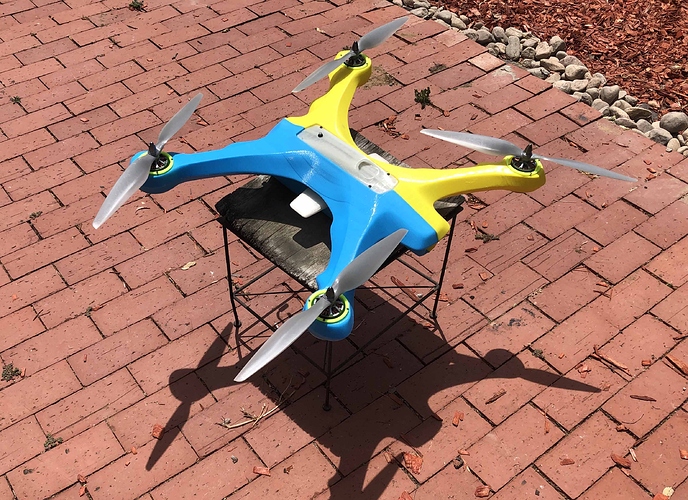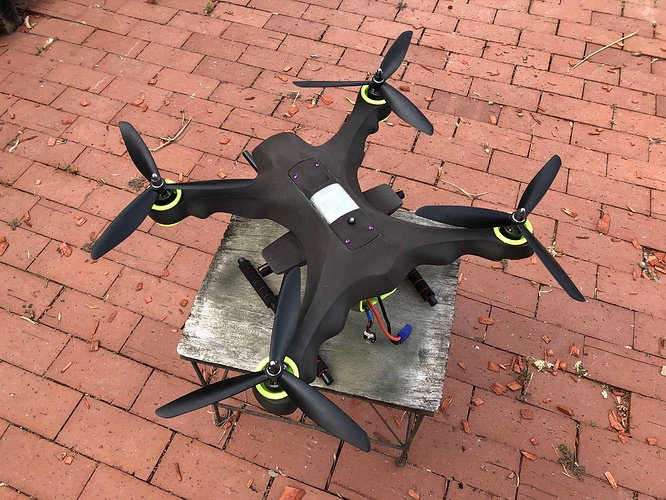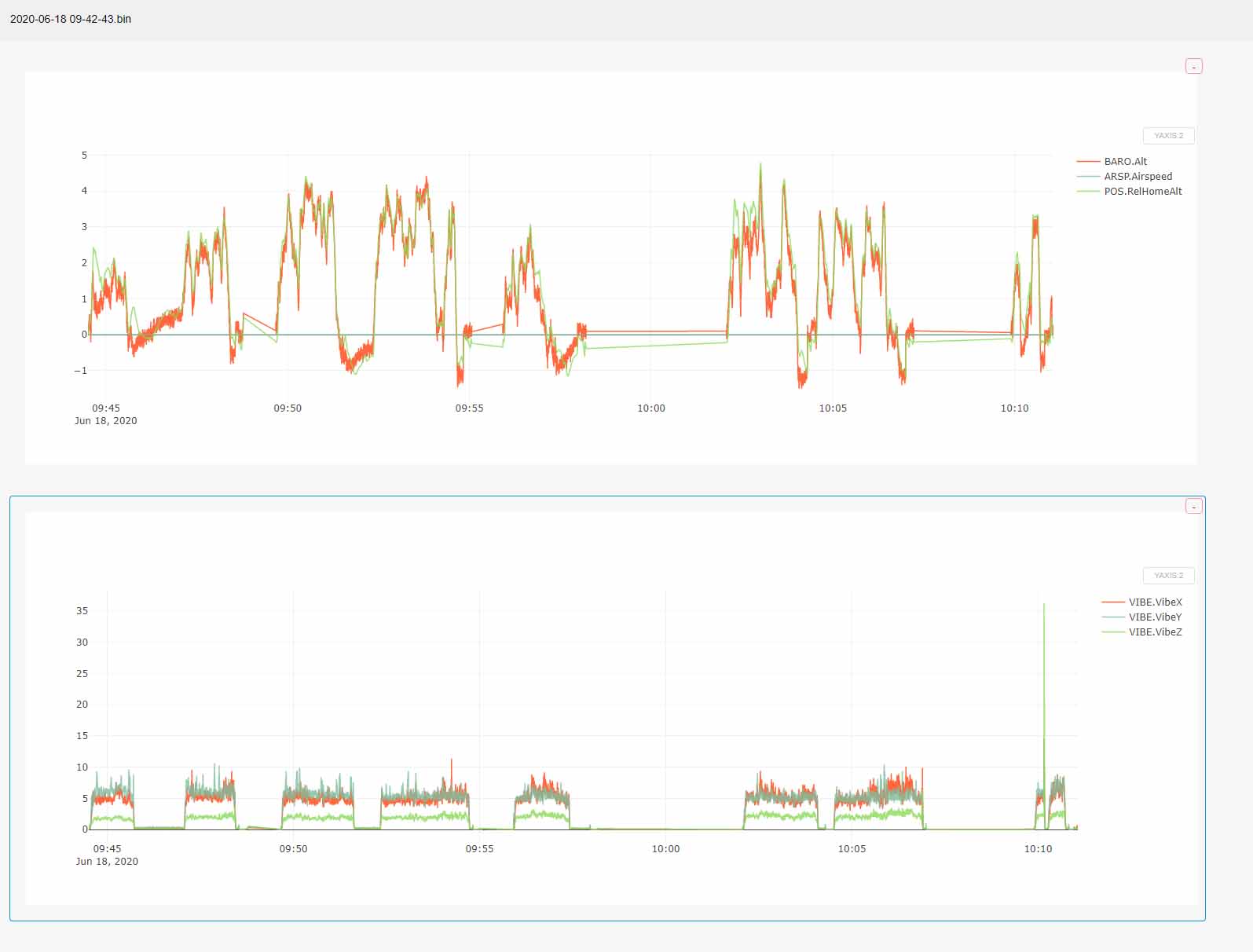Referring to a mount like this: How to build the Pixhawk/APM vibration damping mount - Guides - DroneTrest
Ok cool. I would have referred to that as a 3D Printed Anti-Vibration Platform. Thanks for the link.
It’s not 3d printed, it consists of 2 carbon fibre plates.
This is very interesting and actually makes a lot of sense! I see it’s also mentioned in the documentation:
https://ardupilot.org/copter/docs/common-vibration-damping.html#advice-for-reducing-vibrations
Looking at the photos, your props do pass pretty close to the arms, have you considered this as a possible culprit?
The only thing is Philip Rowse does not like the idea. However it’s a case by case issue. I get rock solid video with the Tarot. but my frames have low flex and only a few bolts. I chimed in as my z was a little higher than normal on my Zero 10 prop build I made a few days ago. top image is the 16" prop and bottom is the 10" the high z was with a 10" frame that could be the wires or battery chatter.
I had not really considered this before posting here. I’m sure it’s worth investigating though. I suppose the easiest way to get some more clearance between the props and the arms would be to add standoffs underneath the motors. On the other hand, I don’t feel like the props are really any closer to the arms than some other vehicles, even in this size range. At this point I’m definitely not ruling anything out though.
How does if fly it could be a simple as tuning. I wondering if the software has a glitch? in my case the other vibration is low. Most of the times all channels are closer.
RC Traditional Helicopters with GAS engines have higher vibrations by design. You could look for their solutions as well.
Just curious if you made any new discoveries to solve this?
I have yet to completely resolve the problem, but I have learned a few things so far. I’ve been running some tests on a vehicle with a comparable blade passing frequency (~115 Hz) that is already tuned before moving to the one mentioned in this post. I’m finding that the Moongel has a terrible resonance around this frequency and will absolutely be the first thing to go. I’ve seen some promising by hard mounting the FC and using the mount in this post: New 3D printed vibration mount for the Cube
I’m be sure to provide some data to support these claims after running a few more tests.
Here are my new vibration numbers with a hard mounting no isolation " 2.1 777 " and screws directly on frame no tape no rubber.
I using master air 12" props. on a 1 meter VTOL.Hey Nick,
This post is very interesting me as my situation is almost identical to yours.
Frame and Class: 1600mm Octa
Flight Controller: Pixhawk 2.1 Cube
Motors: TMotor Navigator MN605-170KV
Propellers: TMotor 22x6.6
ESC: TMotor Alpha 60
Takeoff Weight: 20-35 kg
30mm booms
Propeller have a near perfect static and dynamic balance when spun on the ground.
Like you my Z-Axis vibes, especially on IMU2 are crazy high and clipping. All my vibration levels are very similar to yours just my frequencies are obviously different. I am starting to run out of ideas. I just received the same rubber ball damper you were talking about and I am hopefully going to try it today. Let you know how it goes…
I can save you a little time though.
a) Don’t bother hard mounting the FC, I can almost guarantee it will be worse. (unless it’s easy to do then go for it)
b) Don’t try dampening the motor mounts.
@Quadzilla and clipping for all axis remains 0?
@Nick_DeGroote Just thinking out loud: do the increase in clipping correspond to AccZ of any of the IMU1, IMU2 or IMU3?
In the documentation they mention that clipping increases each time the accelerometer max out at 16G. I suppose the 16G could vary depending on which sensor is used and how it’s configured (full scale = 2,4,8 or 16). Anyway, can you see these maxed out peaks?
In the FFT plots you posted, do you know what the unit for the amplitude is?
Most of these IMU’s have a 16G full scale and that’s what they are configured for. One exception is one of the BMI IMU’s (BMI088) used in some FC’s, it’s 24G’s.
“Vibe” data is the standard deviation of the accel output in m/s/s. To look at actual acceleration data you have review IMU>ACC (x,y,z).
The Vibe data details:
- Capture the raw x, y and z accelerometer values from the primary IMU
- High-pass filter the raw values at 5hz to remove the vehicle’s movement and create a “accel_vibe_floor” for x,y and z axis.
- Calculate the difference between the latest accel values and the accel_vibe_floor.
- Square the above differences, filter at 2hz and then calculate the square root (for x, y and z). These final three values are what appear in the VIBE msg’s VibeX, Y and Z fields.
@dkemxr So does this mean that if the OP would plot all the IMU.AccZ logs he should see some peaks clipping at ±16 x 9.8 = ±156.8 m/s/s? Can’t remember ever seeing such high values so maybe I’ve got it wrong…
Acceleration units are scaled in G’s.Perhaps if you logged at IMU Raw you might catch some. I believe the clipping events are from interrupt signals from the IMU* so you may not see every one in the log(*).
(*) I inquired about this a few weeks ago and didn’t get a response but it seems logical to me.
Nick following up on my earlier post.
Like I mentioned I tried this silicone ball mount: https://www.amazon.ca/ShareGoo-Absorber-Anti-vibration-Damping-Controller/dp/B07T42YPH4/ref=sr_1_1?dchild=1&keywords=pixhawk+vibration+damper&qid=1592598890&sr=8-1
wow…
My insane clipping is gone. Like 0 clips in over an hour of flight (vs about 20000 in 5 min before)
Also my z-axis vibes when from around 30 down to 2-3…
Hello Experts,
I am also facing the same issue,
my build is
Hexacopter X configuration
40" props,
point to be noted that, its a tethered drone
I have used the vibration damping board,
secured all the wires, done everything which is mentioned in the above discussion
Someone has told me that the Z vibration is due to improper yaw tuning, I wanted to know is that true
Increasing P - Amplitude will increase
• Increasing I - Frequency will increase.
Which means If Amplitude changes, focus on P gain and if Frequency changes than focus on I gain.
this is what he told me.
If anyone have any solution apart from these, it would be a great help
thanks you
Please open a new thread and post a .bin file,


